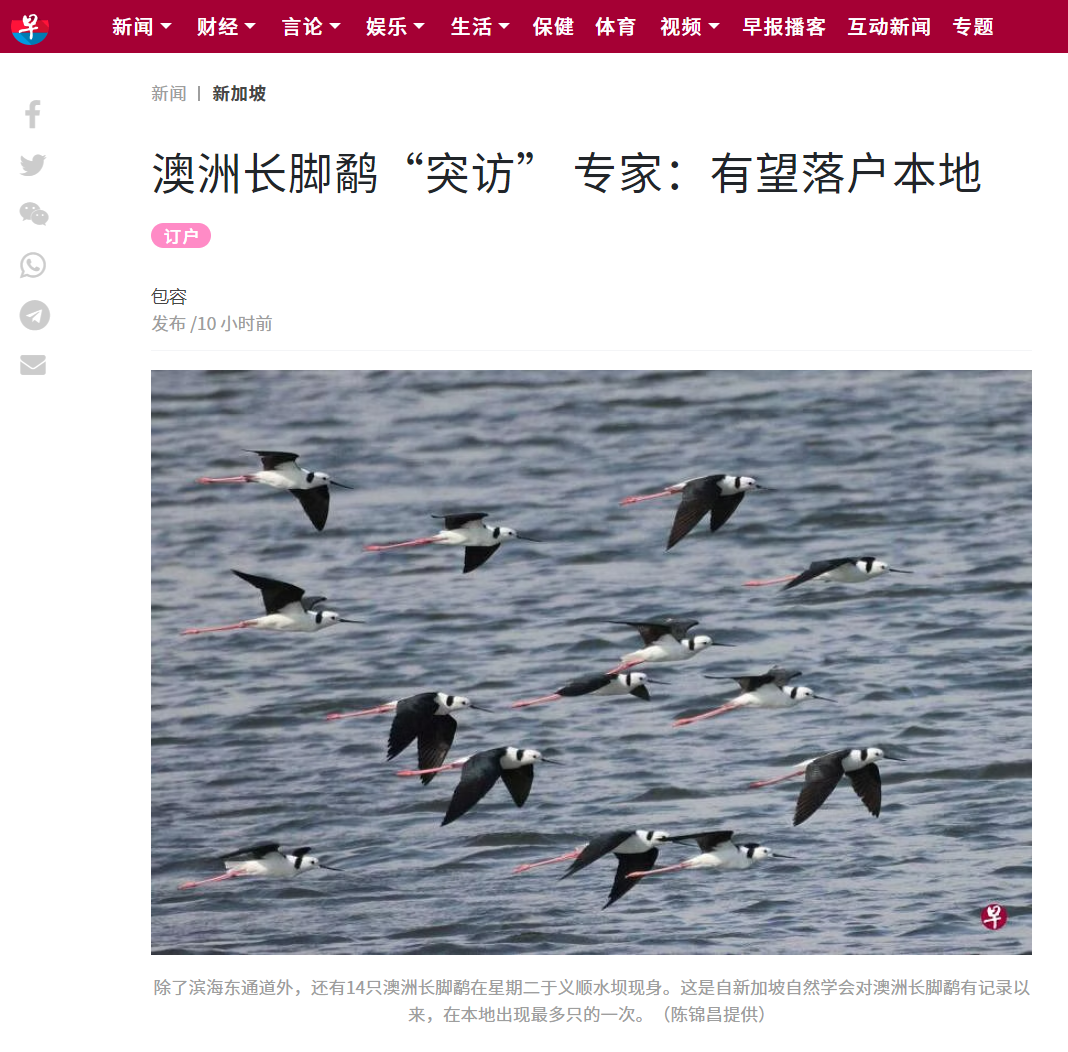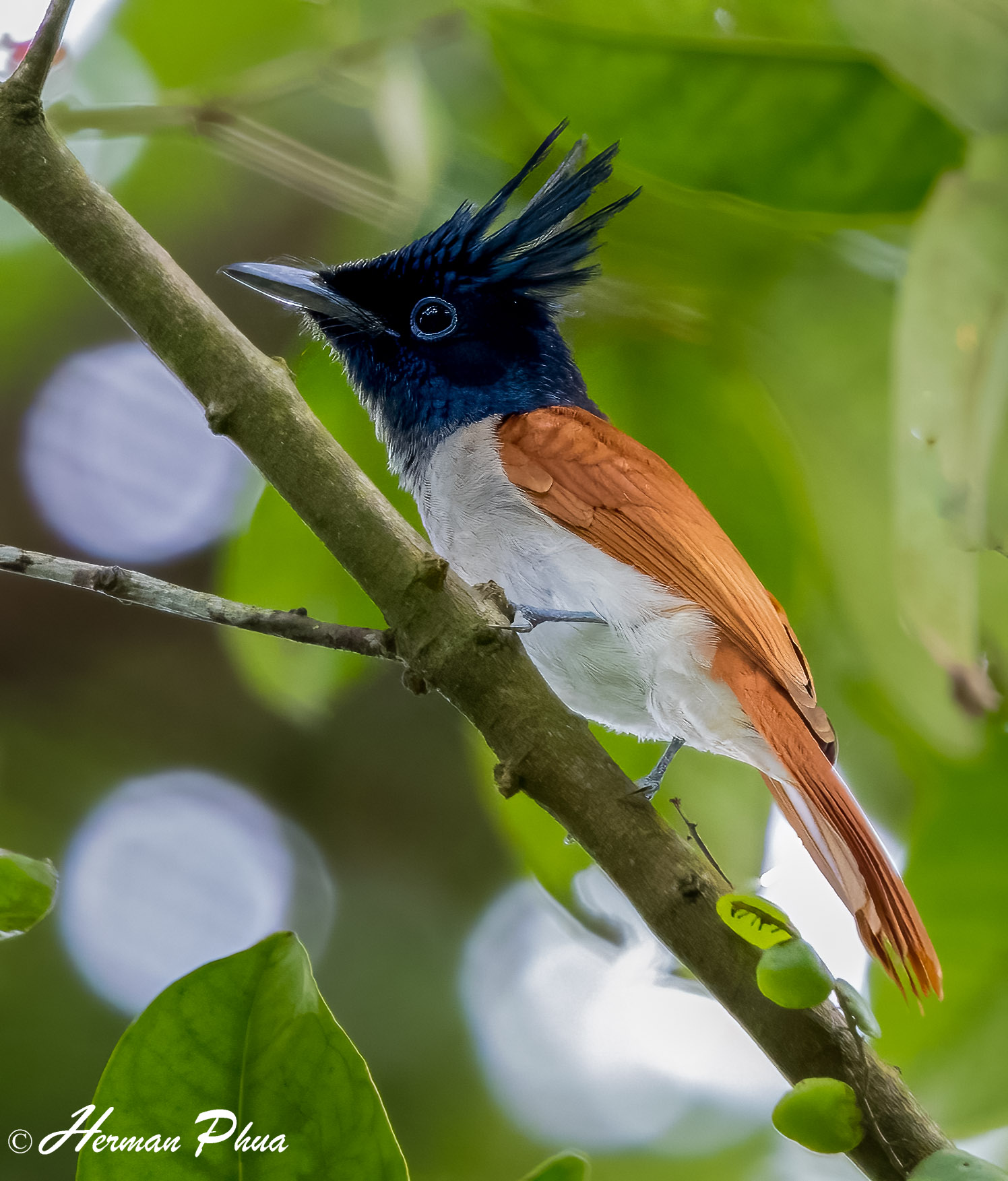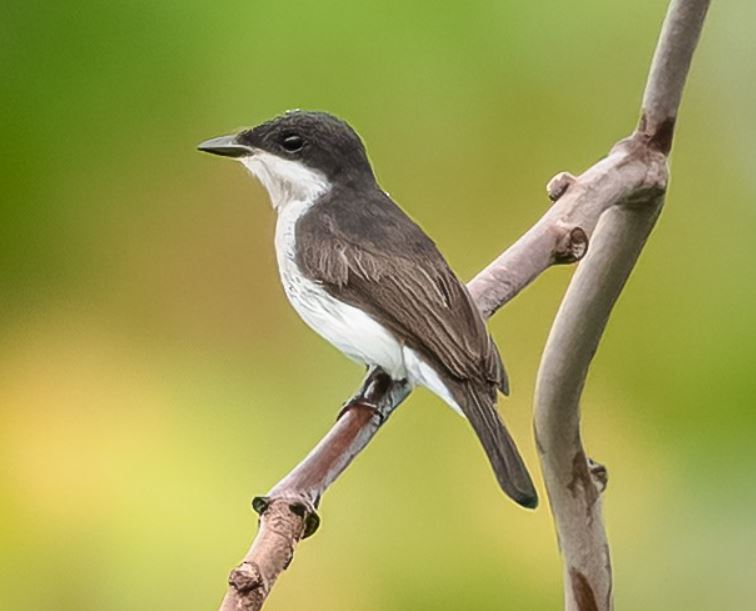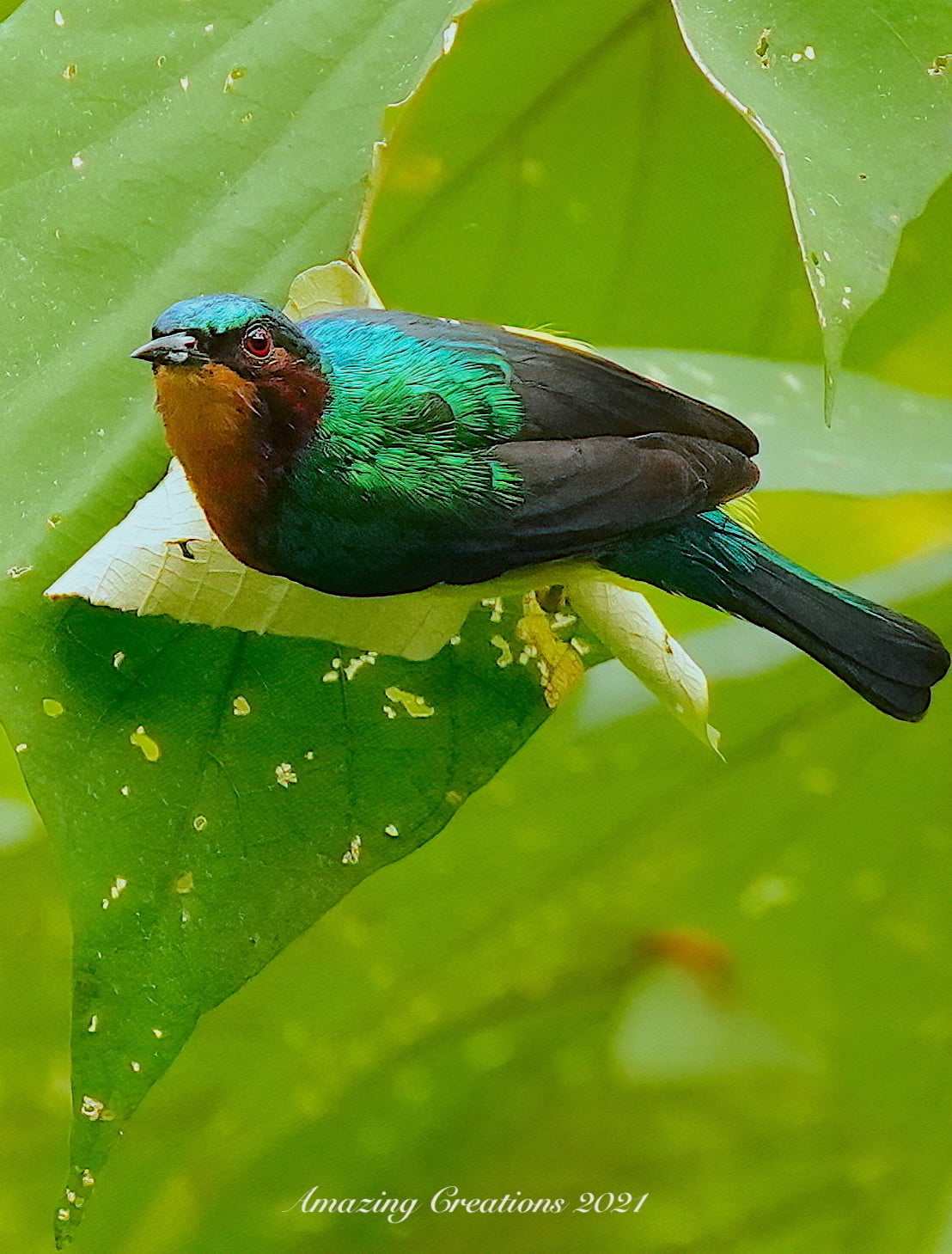by Geoff Lim, Isabelle Lee,
& Tan Gim Cheong (ed.)
This month, we received reports of five spectacular finds: three first records in the form of an Ashy-headed Green Pigeon, a Spotted Flycatcher and a Tree Pipit, a second record Fairy Pitta, and a Mangrove Whistler, a bird seldom encountered on the main Singapore island.

Ashy-headed Green Pigeon by Art Toh, taken on 10 October 2021 at Dillenia Hut.
Central Catchment Nature Reserve (CCNR)
The first ever record of an Ashy-headed Green Pigeon, Treron phayrei, was reported on 9 Oct 2021 by Yip Jen Wei, who found the bird near Dillenia Hut. The bird was subsequently seen with Pink-necked Green Pigeon, Treron vernans, and fed on the fruiting Vitek pinnata and Leea indica growing on the banks of the stream and was last seen on 11 Oct 2021. Opinion is divided between whether the pigeon was an escapee or a wild bird, as the species is not found beyond Thailand and is known to be frequently trapped in Indochina. Other species seen within the core CCNR included a Short-tailed Babbler, Pellorneum malaccense, seen on 3 Oct 2021 by Max Khoo, a rare Black-naped Monarch, Hypothymis azurea, on 12 Oct 2021 by Oliver Tan, and three Cream-vented Bulbul, Pycnonotus simplex, spotted on 14 Oct 2021 by Oliver Tan.

Fairy Pitta by Art Toh, taken on 31 October 2021 at Hindhede Nature Park.
Singapore’s second record of the Fairy Pitta, Pitta nympha, was spotted on the second last day of the month, 30 Oct 2021 by Vincent Lao at Hindhede Nature Park. Vincent was looking for a tree shrew when he spotted the bird in the dark understorey. Other species spotted included a Laced Woodpecker, Picus vittatus, spotted on 19 Oct 2021 by Jonathan Lin, an Oriental Dwarf Kingfisher, Ceyx erithaca, on 20 Oct 2021 by John Ascher and a Changeable Hawk-Eagle, Nisaetus cirrhatus, on 21 Oct 2021, by Vinokumar Saranathan.
At Bukit Timah Nature Reserve, a Yellow-vented Flowerpecker Dicaeum chrysorrheum was photographed by Francis Yap on 26 Oct 2021, and a Chestnut-bellied Malkoha, Phaenicophaeus sumatranus, was seen on 28 Oct 2021 by Jeff Tan.
Visitors to Dairy Farm Nature Park reported seeing a variety of resident and migratory forest species. Notably, a Black-crested Bulbul, Pycnonotus flaviventris, was spotted on 8 Oct 2021 by Dillen Ng, and a Ferruginous Flycatcher, Muscicapa ferruginea, was seen on 10 Oct 2021 by Jonathan Lin. On 17 Oct 2021, a Red-crowned Barbet, Megalaima rafflesii, an Abbott’s Babbler, Malacocincla abbotti, and a Blue-rumped Parrot, Psittinus cyanurus, were seen by Fadzrun A., while an Asian Red-eyed Bulbul, Pycnonotus brunneus, was seen by Darren Leow. On the same day, a pair of Blue-winged Leafbird, Chloropsis cochinchinensis, was seen by Lukasz Wojciech. The next day on 18 Oct 2021, a Brown Hawk-Owl, Ninox scutulata, and a Siberian Blue Robin, Larvivora cyane, were seen by Jon Garcia.
Further away, a Brown-streaked Flycatcher, Muscicapa williamsoni, was spotted on 8 Oct 2021 at the Singapore Quarry by John Ascher, while a Barred Eagle-Owl, Bubo sumatranus, was seen on 16 Oct 2021 by Lua Wai Heng in the woods near Jalan Asas.
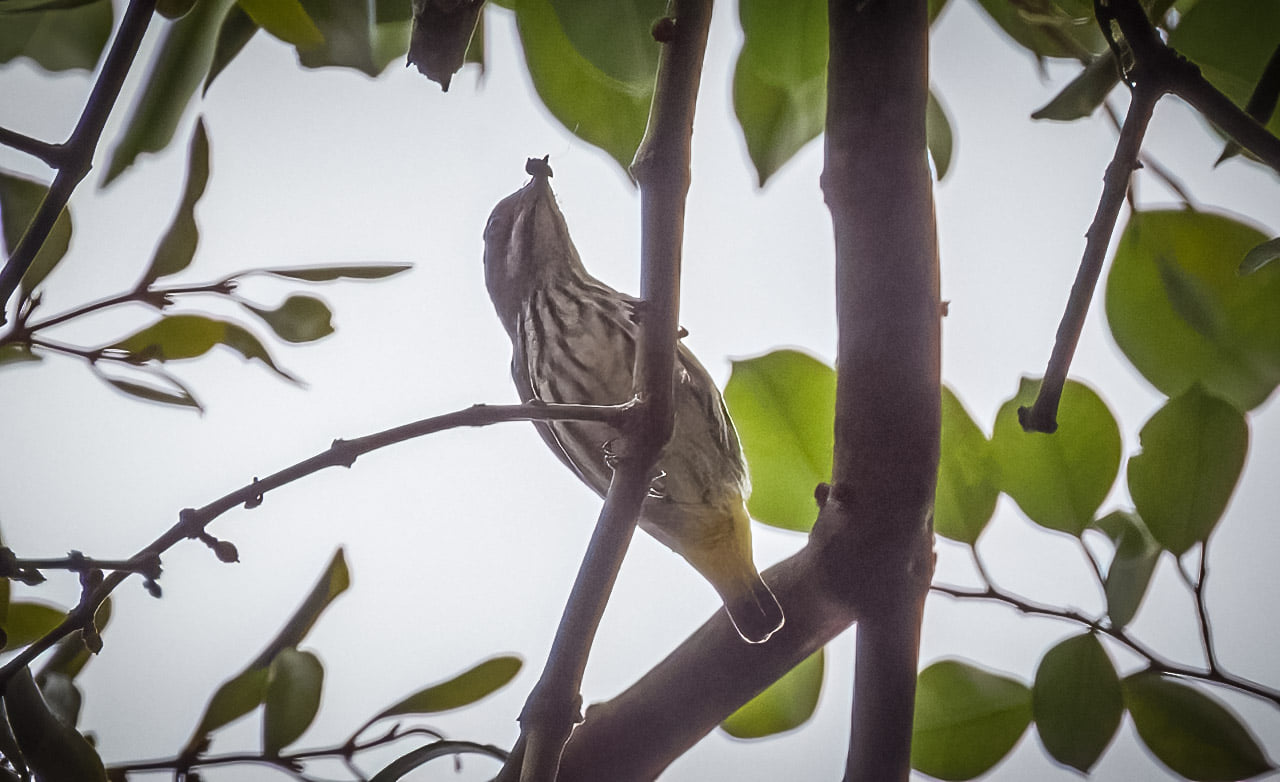
Yellow-vented Flowerpecker by Herman Phua, taken on 29 October 2021 at Bukit Timah hill top.
Singapore Botanic Gardens
Several regular migratory species were reported by visitors on 19 Oct 2021. These included a Common Kingfisher, Alcedo atthis, (Bear Jia), a Crow-billed Drongo, Dicrurus annectans, (Li Si Tay), a Blyth’s Paradise Flycatcher, Terpsiphone affinis, (Hamad Azam), an Amur Paradise Flycatcher, Terpsiphone incei, (Bear Jia) and an Eastern Crowned Warbler, Phylloscopus coronatus, (Vinokumar Saranathan). On 24 Oct 2021, Ted Kiku photographed a Brown Shrike Lanius cristatus preying on a Swinhoe’s White-eye Zosterops simplex.
Residents include a pair of Asian Palm Swift, Cypsiurus balasiensis, seen on 14 Oct 2021 (Joshua Chong), a House Swift, Apus nipalensis, spotted on 18 Oct 2021 (Chen Boon Chong), eight Lesser Whistling Duck, Dendrocygna javanica, seen on 19 Oct 2021 (Joshua Chong), a solitary Black-crowned Night Heron, Nycticorax nycticorax, spotted on 19 Oct 2021 (Bear Jia), a Grey-headed Fish Eagle, Haliaeetus ichthyaetus, seen on 19 Oct 2021 (Tuck Loong Kwok) and a pair of Coconut Lorikeet, Trichoglossus haematodus, seen on the same day (Joshua Chong).
Northern Singapore
The Sungei Buloh Wetland Reserve (SBWR) yielded a number of waders, such as a solitary Terek Sandpiper, Xenus cinereus, on 10 Oct 2021 (Lukasz Wojciech), 150 Pacific Golden Plover, Pluvialis fulva and 130 Whimbrel, Numenius phaeopus, as well as 30 Common Redshank, Tringa totanus, on 23 Oct 2021 (Lim Kim Chuah). Four Copper-throated Sunbird, Leptocoma calcostetha, were spotted that 17 Oct 2021 by Charles Bokman, while a Drongo Cuckoo, Surniculus lugubris, was seen on7 Oct 2021 (Evelyn Lee), and four Lesser Adjutant, Leptoptilos javanicus, were counted seven days later on 14 Oct 2021 by young Kaeden Sim.
Over at Neo Tiew Harvest Lane, a lurking Cinnamon Bittern, Ixobrychus cinnamomeus, was spotted on 9 Oct 2021 (Fadzrun A), a Red Turtle Dove, Streptopelia tranquebarica, 17 Oct 2021, was seen at Kranji Marsh (Kaeden Sim).
Punggol Park was fruitful with a Forest Wagtail, Dendronanthus indicus, a Yellow-rumped Flycatcher, Ficedula zanthopygia, and three Pied Imperial Pigeon, Ducula bicolor, on 20 Oct 2021 by Kwok Tuck Loong.
Eastern Singapore
Visitors to Pulau Ubin reported seeing two Grey Plover, Pluvialis squatarola, on 10 Oct 2021 at Chek Jawa (YK Han), two White-rumped Shama, Copsychus malabaricus, on 18 Oct 2021 (John Chin), and three Blue-winged Pitta, Pitta moluccensis on 28 Oct 2021 (Lim Yu Jun). Over at the canal along Changi Business Park, a single Green Imperial Pigeon, Ducula aenea, was seen on 19 Oct 2021 (Vish M), as was a Brown Shrike, Lanius cristatus, and a pair of Large-billed Crow, Corvus macrorhynchos, on 21 Oct 2021 (Vish M). Other sightings in the east include five White-shouldered Starling, Sturnia sinensis, one Dark-sided Flycatcher, Muscicapa sibirica, and one Black-browed Reed Warbler, Acrocephalus bistrigiceps, on 11 Oct 2021 at Tampines Eco Green (Kwok Tuck Loong), and a pair of Spotted Wood Owl, Strix seloputo, on 20 Oct 2021 along Changi Coast Road (Tay Li Si).
Southern Singapore

Mangrove Whistler by Karen Chiew, taken on 9 October 2021 at Berlayer Creek.
Two of the five major discoveries for October 2021 were made in southern Singapore. A single Mangrove Whistler, Pachycephala cinerea, was found lurking in the mangroves along Tanjong Berlayer Creek on 9 Oct 2021 by Karen Chiew, while a Spotted Flycatcher, Muscicapa striata, the first for Singapore, was discovered on 15 Oct 2021 at Kent Ridge Park by Alex Kang.

Spotted Flycatcher by Geoff Lim, taken on 23 October 2021 at Kent Ridge Park.
Early birds seen in the south were a Large Hawk-Cuckoo, Hierococcyx sparverioides, seen on 1 Oct 2021 by the indefatigable Ramesh T. at Dover Road, while a Blue Rock Thrush, Monticola soltarius, was seen on 5 Oct 2021 at the Pinnacle@Duxton by the young and talented Kaeden Sim.
Sightings from the Southern Ridges included thirty Pacific Swift, Apus pacificus, on 18 Oct 2021 along Henderson Waves by Oliver Tan, one Chinese Sparrowhawk, Accipiter soloensis, and one Japanese Sparrowhawk, Accipiter gularis, on 19 Oct 2021 at Telok Blangah Hill Park by Alan OwYong, and a Crested Serpent Eagle, Spilornis cheela, and one Crested Goshawk, Accipiter trivirgatus, on 20 Oct 2021 at Kent Ridge Park by Joshua Chong. Residents included a pair of Van Hasselt’s Sunbird, Leptocoma brasiliana, on 17 Oct 2021 at Mount Faber Park, as reported by Raghav Narayanswamy, and a single White-rumped Munia, Lonchura striata, seen on 23 Oct 2021 at Telok Blangah Hill Park by Tay Kian Guan.
The usual plovers were present at Marina East – three Kentish Plover, Charadrius alexandrinus, one White-faced Plover, Charadrius dealbatus, on 18 Oct 2021 as seen by Kwok Tuck Loong, and four Malaysian Plover, Charadrius peronii, spotted on 19 Oct 2021 by Kaeden Sim. Also seen were seven White-winged Tern, Chlidonias leucopterus, on 7 Oct 2021 by Sylvester Goh and one Whiskered Tern, Chlidonias hybrida, on 18 Oct 2021 by Kwok Tuck Loong.
Island-hoppers contributed with reports of six House Sparrow, Passer domesticus, on 6 Oct 2021 from Sakra Road, Jurong Island (Martin Kennewell), two Eastern Cattle Egret, Bubulcus coromandus, two Oriental Pratincole, Glareola maldivarum, and one Golden-bellied Gerygone, Gerygone sulphurea, on 19 Oct 2021 on Kusu Island (Tan Gim Cheong) and one Chinese Hwamei, Garrulax canorus, on 27 Oct 2021 on Sentosa Island (Max Khoo).
Western Singapore

Tree Pipit by Lim Kim Seng, taken on 31 October 2021 at Ulu Pandan-Clementi Rd junction.
The fifth serendipitous find for the month was a single Tree Pipit, Anthus trivialis, another first for Singapore, found on 23 Oct 2021 in a patch of grass at the Ulu Pandan-Clementi Road junction by Soo Kok Choong. On a previous day, three Buffy Fish Owl, Ketupa ketupu, were seen near the Pine Grove estate on 19 Oct 2021 by Julie Edgley.
Visitors to the monsoon canal along Lim Chu Kang Lane 3 reported seeing a Greater Painted-Snipe, Rostratula benghalensis, on 17 Oct 2021 (Martin Kennewell), one Blue-eared Kingfisher, Alcedo meninting, and two Red Avadavat, Amandava amandava, on 18 Oct 2021 (Raghav Narayanswamy), and nine Little Ringed Plover, Charadrius dubius, and ten Wood Sandpiper, Tringa glareola, one Pallas’s Grasshopper Warbler, Locustella certhiola, one Eastern Yellow Wagtail, Motacilla tschutschensis, and one Grey Wagtail, Motacilla cinerea, on 19 Oct 2021 (Kaeden Sim).
Tuas South, which is the western-most end of Singapore, yielded a mix of usual and spectacular migrants. The reclaimed land off Tuas South Avenue 16 had an Oriental Plover, Charadrius veredus, one Red-necked Stint, Calidris ruficollis, and a pair of Long-toed Stint, Calidris subminuta, seen on 6 Oct 2021 (Martin Kennewell). The area also yielded a Chestnut-winged Cuckoo, Clamator coromandus, a Hodgson’s Hawk-Cuckoo, Hierococcyx nisicolor, and a Brown-chested Jungle Flycatcher, Cyornis brunneatus, on 19 Oct 2021 (Raghav Narayanswamy).
This report is compiled/written by Geoff Lim and Isabelle Lee and edited by Tan Gim Cheong. We are grateful for the birders and photographers whose postings in various Facebook birding pages, bird forums, individual reports and extracts from eBird make up this report. This compilation is not a complete list of birds recorded for the month and not all the records were verified.
Many thanks to Art Toh, Herman Phua, Karen Chiew, Geoff Lim & Lim Kim Seng for allowing us to use their photographs.








